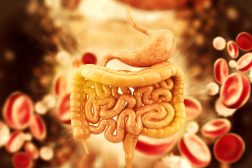Principles of Hormonal Control Systems

The endocrine system is comprised of a system releasing hormones that act as chemical messengers
Table of Contents
Hormones are chemical messengers that enter the blood directly upon their secretion from endocrine glands. A single gland or cell may secrete multiple hormones and multiple glands may secrete the same single hormone.
Major classes of hormones:
- Amine Hormones – Derivative of the amino acid tyrosine.
- Thyroid Hormones – The thyroid gland is located in the lower neck, wrapped around the trachea. Consists of follicles that secrete the two iodine-containing hormones thyroxine (T4) and triiodothyronine (T3). These thyroid hormones (TH) regulate oxygen consumption, growth and brain development. T4 is secreted in larger amounts but is mostly converted to T3, the more active form.
- Adrenal Medullary Hormones – There are 2 adrenal glands, one on top of each kidney. Each gland has 2 endocrine parts, an inner adrenal medulla, and a surrounding adrenal cortex. The medulla secretes epinephrine (E) and norepinephrine (NE) which are catecholamines. These hormones exert actions similar to those of sympathetic nerves. More epinephrine than norepinephrine is secreted.
- Peptide Hormones – The majority of hormones. Initially synthesized as larger preprohormones that are then cleaved to prohormones in the ER. The prohormone is then cleaved to the active hormone in the Golgi. These hormones may also serve as neurotransmitters. Calcitonin, a peptide hormone secreted by parafollicular cells of the thyroid gland, participates in the regulation of blood Ca2+ level.
- Steroid Hormones – Produced by the adrenal cortex and the gonads.
- Adrenal Cortex Hormones – Aldosterone participates in mineral balance (mineralocorticoid) by controlling the handling of Na+, K+, and H+ ions by the kidney. Cortisol and corticosterone affects the metabolism of glucose (glucocorticoid) and other organic nutrients. Cortisol also affects stress responses and regulation of the immune system. Adrenal androgens are less potent than the other androgen, testosterone. Play some role at puberty and some in the adult female.
- Hormones of the Gonads – Testosterone is the major androgen secreted by the testes. The major female hormone, estradiol, secreted by the ovaries, is derived from androgens.
Hormone Transport in Blood
Water-soluble hormones are transported dissolved in blood plasma while others circulate in blood, bound to plasma proteins. The free hormone diffuses across capillary walls to encounter its target cells.
Hormone Metabolism and Excretion
The concentration of a hormone in plasma depends upon its rate of secretion and rate of removal. Hormones are either excreted by kidneys or metabolized in blood or the target cells.
Mechanisms of Hormone Action
Hormones reach all tissues via blood but only cells that have receptors to bind the hormone act as target cells for the hormone. A low concentration of hormones is compensated for by an increase in the number of receptors – up-regulation while a high concentration of hormones leads to a decrease in the number of receptors – down-regulation. A hormone can reduce the number of receptors available for a second hormone, resulting in decreased effectiveness of the second hormone (antagonism). A hormone can also induce an increase in the number of receptors for a second hormone, increasing the latter’s effectiveness (permissiveness).
Events Elicited by Hormone-Receptor Binding
Receptors for peptide hormones and catecholamines are present on the extracellular surface of the plasma membrane while those for steroid and thyroid hormones are mainly present on the intracellular surface of the membrane. Hormone-receptor binding influences: (1) ion channels, (2) enzyme activity that is part of the receptor, (3) activity of JAK kinases, and (4) G proteins and second messengers. Genes could also be activated or inhibited, causing a change in the synthesis rate of proteins coded for by these genes.
Control of Hormone Secretion
- Control by plasma concentrations of specific substances: Plasma concentrations of specific ions or nutrients may control the secretion of a hormone and the hormone may, in turn, control the concentration of its regulators in a negative feedback manner.
- Control by neurons: Secretion of some hormones may be under the control of autonomic or central nervous system
- Control by other hormones: Hormones called tropic hormones may control the secretion of other hormones.
- Control system involving the hypothalamus and pituitary: Pituitary gland (hypophysis) lies below the hypothalamus and is connected to it by the infundibulum.
The pituitary has 2 lobes:
- Posterior pituitary (neurohypophysis) – A neural extension of the hypothalamus. Posterior pituitary hormones are actually produced in the hypothalamus but are stored in the posterior pituitary. The hormones (a) oxytocin stimulates contraction of smooth muscles in breasts and uterus of females and (b) vasopressin (antidiuretic hormone or ADH) participates in the control of water excretion and regulates blood pressure.
- Anterior pituitary (adenohypophysis) – Connected to the hypothalamus by blood vessels called hypothalamo-pituitary portal vessels. Hypothalamic hormones called hypophysiotropic hormones control the secretion of anterior pituitary hormones (all peptides), which in turn control the secretion of other hormones from other endocrine glands. The adaptive value of such a chain of control is that it allows more precise feedback control.
Thyroid-stimulating hormone (TSH, thyrotropin) induces secretion of T4 and T3 from the thyroid. Adrenocorticotropic hormone (ACTH) stimulates the secretion of cortisol by the adrenal cortex. The gonadotropins, Follicle-stimulating hormone (FSH) and luteinizing hormone (LH) stimulate secretion of estradiol and progesterone from ovaries and testosterone from testes, as well as regulate the growth and development of ova and sperm. Growth hormone (GH) stimulates the liver to secrete a growth hormone called insulin-like growth factor I (IGF-I), and exerts direct effects on metabolism. Prolactin does not exert control over the secretion of another hormone but stimulates the development of mammary glands and milk production in females.
Hypophysiotropic Hormones
These hormones are secreted by neurons in response to action potentials. Each of these hormones is named after the anterior pituitary hormone that it controls. Corticotropin-releasing hormone (CRH) stimulates the secretion of ACTH. Growth hormone-releasing hormone (GHRH) stimulates the secretion of GH. Thyrotropin-releasing hormone (TRH) stimulates the secretion of TSH or thyrotropin. Gonadotropin-releasing hormone (GnRH) stimulates the secretion of gonadotropins (FSH and LH). Somatostatin (SS) inhibits the secretion of GH. Prolactin-inhibiting hormone (PIH) inhibits the secretion of prolactin.
Feedback Control of the Hypothalamus and Anterior Pituitary
If the last hormone in a chain of control can exert negative feedback on the hypophysio-pituitary system, it is called long-loop negative feedback. If an anterior pituitary hormone exerts a negative feedback effect on the hypothalamus, it is called short-loop negative feedback. Seen for pituitary hormones that do not influence other endocrine glands.
Candidate Hormones
Candidate hormones do not fit the classical description of hormones because:
- Their functions are not conclusively documented, e.g., melatonin produced by the pineal gland probably plays an important part in circadian rhythms and sleep.
- They act as agents but it is not certain if they reach the
target cells via paracrine/autocrine blood, e.g., growth factors
Endocrine Disorders
- Hyposecretion – If a gland is secreting too little hormone because it itself is unable to function normally, the disorder is called primary hyposecretion. Causes could be genetic lack of an enzyme, dietary deficiency of a precursor, infection, etc. If a gland is secreting too little hormone because there is too little tropic hormone to stimulate it, the disorder is called secondary hyposecretion.
- Hypersecretion – Primary hypersecretion is a gland itself secreting too much hormone while secondary hypersecretion is the excessive stimulation of a gland by its tropic hormone.
- Hyporesponsiveness – Target cells do not respond to the hormone due to a deficiency of receptors, a defect in the signal transduction mechanism or a deficiency of an enzyme that catalyzes the activation of the hormone. In diabetes mellitus, the target cells of the hormone insulin are hyporesponsive.
- Hyperresponsiveness – Hypersecretion of thyroid hormones can lead to hyperresponsiveness to epinephrine and a consequent increase in heart rate.
You will also like...

Community Patterns
Learn about community patterns and the ecological factors influencing these patterns. Revisit some of the ecosystems you..

Freshwater Ecology
Freshwater ecology focuses on the relations of aquatic organisms to their freshwater habitats. There are two forms of co..

Human Biology – Food and Digestion
This tutorial recognizes the importance of food as a source of energy that will fuel many biological processes. A good d..

Gene Action – Operon Hypothesis
Learn how the way genes control and determine every aspect of the body. This lesson uses lac operon as an example. ..
..

Abiotic and Biotic Factors
This tutorial deals with the abiotic factors of the freshwater environment that determine what sort of life would be sui..

Arthropods
The arthropods were assumed to be the first taxon of species to possess jointed limbs and exoskeleton, exhibit more adva..
